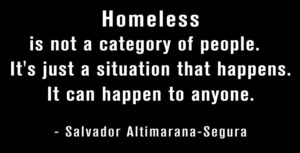No Fixed Address

“No Fixed Address” is dedicated to those in our country with no roof over their heads. See your neighbors, your friends, your relatives, in new ways as they describe their daily lives in their own words.
The people in this new book reveal themselves to be both brave and fearless as they go about their activities: work, laundry, children’s homework, appointments. Mostly they live like the rest of us. They just have no roof over their heads.
“No Fixed Address” is my newest book in the Unworthy Hungry series. It’s easy to read and understand. You won’t be bored, not even for a minute.
I hope you’ll order it today. Get an extra copy for a friend!
This book has an extra surprise. When you get a copy, you’ll be making a donation to a good cause. You’ll be fighting hunger and homelessness.
It doesn’t get much better than that!
Thank you for reading this article!
Please forward it to your preferred social media network.
Thurman Greco


Hunger Blog – Hunger is Not a Disease at the Food Pantry.
In March, 2011, Mark Bittman of the New York Times wrote an opinion piece entitled “Hunger is a Disease.” The following post is my response to his story.
HUNGER IS NOT A DISEASE
Hunger is many different things to many different people…depending on the conditions they live in.
Because I’m the coordinator of a food pantry in Ulster County, New York, I see the many faces of hunger every week.
I see the hunger of the line as people stand outside the building, sometimes for as much as an hour, to get a three-day supply of food which must last seven days. I try to “pad the bill” as they say, by bringing in as many different kinds of fresh produce, dairy products, and bread into the pantry weekly as I can. My policy here: take as much as you can eat for three days.
The three-day limit is a Hunger Prevention Nutrition Assistance Program (HPNAP) guideline. And, it’s a practical one. The fresh produce really isn’t going to last much more than three days. So, everybody gets to take all they can eat in three days.
I see hunger in the condition of people coming to the pantry weekly with absolutely no money for food. These people, while receiving a three-day supply of food which will last for seven days, are doing without MUCH: salt, pepper, sugar, flour, fresh milk, cooking oil, coffee.
Often these people, like the members of the Flores family, are working seven days a week – every week. Every family member has more than one job. They manage to bring in enough funds to pay the rent for a cramped apartment and to buy gas. Period. No insurance. No food. No clothes. Thank God for the free clothes at the Family Clothes Closet.
When I think about it, I realize that everything they get is recycled: the apartment they rent is old and rundown. The family pickup is definitely used. The clothing is brought over to Family by people who no longer plan to use it.
The food, likewise, is recycled: the produce, dairy, and bread was definitely on its way to the landfill when it got diverted and sent to the Food Bank.
The canned goods were all diverted at the grocery store from the landfill. The cans are dented. Many are outdated. Some have no labels anymore.
The boxed goods are the worst…especially the crackers. A box of crackers is really a box of cracker crumbs.
No matter, the people are grateful for what they get. It’s better than nothing.
For the most part, the people shopping at our pantry are what the survey labels resource poor. Resource poor routinely choose between food and utilities, food and housing payments, food and medicine/medical care, food and transportation, food and gasoline.
And, of course, people in the resource poor category are also food insecure. They lack, at times, enough food for an active, healthy life for the household members.
It’s physically challenging to work three jobs on insufficient food. Hungry school children have a much harder time learning than their well fed classmates.
There are many articles, books written about global hunger. For me, global hunger is not a focus. What DOES exist is the hunger in my pantry, my neighborhood, my community.
Hunger is a condition. It accompanies malnourishment.
As Mark Bittman of the New York Times says: “Hunger can lead to starvation; starvation to death.”
Thank you for reading this blog/book.
Please share this article with your favorite social network.
Please send a comment.
Peace and food for all.
Thurman Greco








